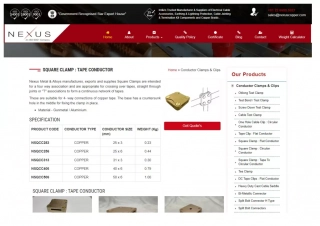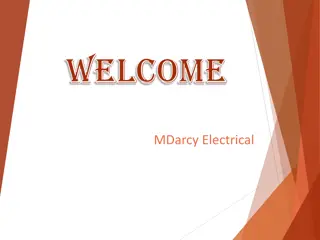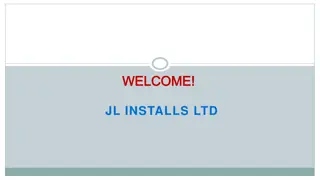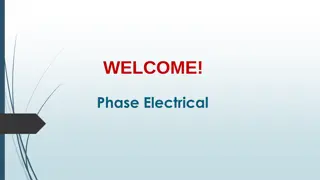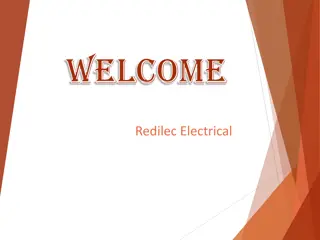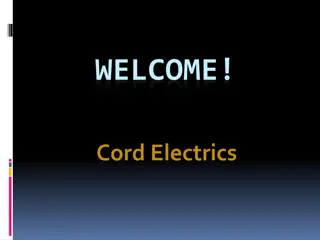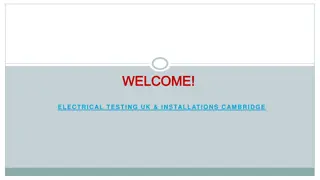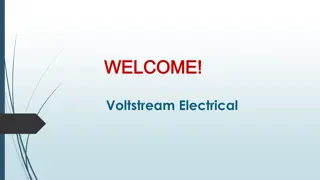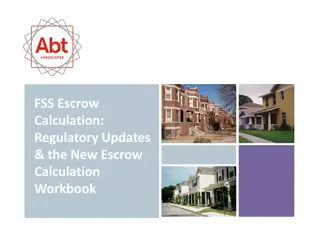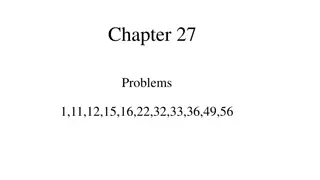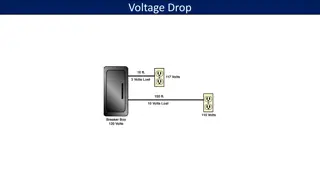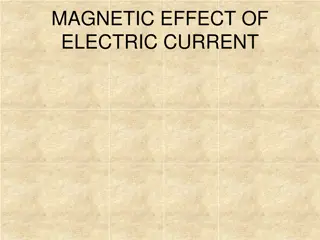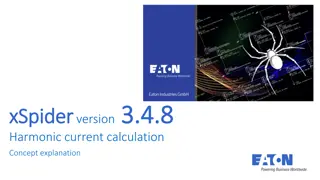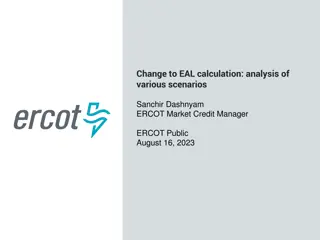Electrical Conductor Ampacity Calculation Scenarios
Various scenarios are presented involving the calculation of allowable ampacity for different types of electrical conductors connected to circuit breakers with temperature limitations. The calculations consider factors like conductor material, size, temperature ratings, and ambient conditions to determine the safe operating ampacity. Examples include aluminum and copper conductors connected to circuit breakers with specific temperature limitations.
Download Presentation

Please find below an Image/Link to download the presentation.
The content on the website is provided AS IS for your information and personal use only. It may not be sold, licensed, or shared on other websites without obtaining consent from the author. Download presentation by click this link. If you encounter any issues during the download, it is possible that the publisher has removed the file from their server.
E N D
Presentation Transcript
110.14(C) Temperature Limitations Question 1 A 2 AWG THHN aluminum conductor is connected to a circuit breaker with termination temperature limitation marked (not to exceed) 60 C and marked for CU/AL conductors. What is the allowable ampacity of the 2 AWG THHN aluminum conductor now that it is connected to this circuit breaker? 110.14(C)(a)(2)
110.14(C) Temperature Limitations Question 1 A 2 AWG THHN aluminum conductor is connected to a circuit breaker with termination temperature limitation marked (not to exceed) 60 C and marked for CU/AL conductors. What is the allowable ampacity of the 2 AWG THHN aluminum conductor now that it is connected to this circuit breaker? 110.14(C)(a)(2) Answer 110.14(C)(1)(a)(2) applies CB terminations = 60 C Table 310.15(B)(16) Allowable Ampacity Limited by CB to 60 C THHN ampacity @ 90 C not permitted Use ampacity of 2 AWG Al @ 60 C 2 AWG THHN aluminum = 75 amps Answer: 75 A
Question 2 What is the allowable ampacity of the 4/0 AWG THWN copper conductor connected to a circuit breaker with wire connection temperature limitation marked (not to exceed) 75 C? 110.114(C)(1)(b)(2)
Question 2 What is the allowable ampacity of the 4/0 AWG THWN copper conductor connected to a circuit breaker with wire connection temperature limitation marked (not to exceed) 75 C? Answer 110.14(C)(1)(b)(2) applies CB terminations = 75 C Table 310.15(B)(16) Allowable Ampacity Limited by CB to 75 C THWN ampacity @ 75 C Use ampacity of 2 AWG Al @ 60 C 4/0 AWG THWN copper = 230 amps Answer: 230 A 110.114(C)(1)(b)(2)
Question 3 Eight 6 AWG THHN copper current-carrying conductors are installed to replace existing wiring within an existing single rigid metal conduit, Type RMC. The area of installation has an ambient temperature of 30 C. The new eight 6 AWG THHN conductors are connected to existing 50-ampere 2-pole circuit breakers with a marked terminal temperature rating of 60 C. What is the ampacity of the conductors, and is this an acceptable installation?
Question 3 Eight 6 AWG THHN copper current-carrying conductors are installed to replace existing wiring within an existing single rigid metal conduit, Type RMC. The area of installation has an ambient temperature of 30 C. The new eight 6 AWG THHN conductors are connected to existing 50-ampere 2-pole circuit breakers with a marked terminal temperature rating of 60 C. What is the ampacity of the conductors, and is this an acceptable installation? Answer Table 310.15(B)(16) Allowable Ampacity 6 AWG THHN @ 90 C = 75 amps Table 310.15(B)(3)(a) Adjustment Factors 8 current-carrying conductors = 70% 75 amps 0.70 = 52.5 amps 6 AWG in 60 C column = 55 amps 55 amps is not permitted Ampacity = 52.5 amps Answer: 52.5 A
6 Receptacles 210.52 (A)(1) & (A)(2)
When a household wall-mounted oven is tapped from a 50-ampere branch circuit, the ampacity of the tap conductors shall not be less than __ .
When a household wall-mounted oven is tapped from a 50-ampere branch circuit, the ampacity of the tap conductors shall not be less than __ . a. 20 A ** b. 25 A c. 30 A d. 35 A 210.19(A)(3) Exception No. 1
What is the minimum ungrounded conductor(s) feeder demand for two 3 kW household electric ovens in a dwelling unit?
What is the minimum ungrounded conductor(s) feeder demand for two 3 kW household electric ovens in a dwelling unit? Solution: Table 220.55, Note 3 permits two options. Calculate both options and select the smaller. Option 1 Table 220.55, Column A Two units less than 31/2 kW 2 units = 75% Line = 2 units 3 kW 0.75 = 4.5 kW Option 2 Table 220.55, Column C 2 units = 11 kW Selection: Option 1 gives smaller load Answer: 4.5 kW
A fixed appliance in a dwelling unit has a nameplate marking of 50 amperes. What is the rating of the individual branch circuit required to supply this appliance? The load is noncontinuous.
A fixed appliance in a dwelling unit has a nameplate marking of 50 amperes. What is the rating of the individual branch circuit required to supply this appliance? The load is noncontinuous. a. b. c. d. 40 A 50 A * 60 A 62.5 A Note: Individual branch circuits are permitted to supply any load for which they are rated. See 210.23. If, in addition to the appliance, other loads are served from the same branch circuit, see 422.10(B).
What is the lighting load for a 625 square foot structural addition to an existing one-family dwelling?
What is the lighting load for a 625 square foot structural addition to an existing one-family dwelling? Solution: 220.16(A)(1) Over 500 sq ft use value in Table 220.12 Unit load for dwelling units = 3 VA per sq ft Lighting load = Area x unit load = 625 x 3 = 1,875 VA
Determine the general lighting load for a one-story office building that measures 125 feet by 150 feet.
Determine the general lighting load for a one-story office building that measures 125 feet by 150 feet. Solution: 220.12 and Table 220.12 Unit load for offices = 3-1/2 VA per sq ft Lighting load = Area x unit load = (125 x 150) x 3.5 = 18,750 x 3.5 = 65,625 VA
Only the shell for an office building is to be built. It is 225 feet long, 90 feet wide, and 10 stories high. Calculate the lighting and receptacle feeder demand in volt-amperes for the building with the number of receptacles unknown.
Only the shell for an office building is to be built. It is 225 feet long, 90 feet wide, and 10 stories high. Calculate the lighting and receptacle feeder demand in volt-amperes for the building with the number of receptacles unknown. Solution: Area = L x W = 225 x 90 = 20,250 sq ft 220.12 and 220.14(K) VA per sq ft = 3.5 + 1 = 4.5 VA Demand = Area x VA per sq ft x No. floors = 20,250 x 4.5 x 10 = 911,250 VA
A warehouse is 300 feet by 300 feet with a 120/208-volt, 3-phase, 4-wire service. Calculate the lighting feeder demand in volt-amperes. (The line and neutral lighting feeder demand are the same value.)
A warehouse is 300 feet by 300 feet with a 120/208-volt, 3-phase, 4-wire service. Calculate the lighting feeder demand in volt-amperes. (The line and neutral lighting feeder demand are the same value.) Table 220.12 Unit load for a warehouse = 1/4 VA per sq ft Area = L x W = 300 x 300 = 90,000 sq ft Calc. load = Area x unit load = 90,000 x 0.25 = 22,500 VA Table 220.42, Demand factor Calculated load 22,500 VA First 12,500 at 100% 12,500 = 12,500 VA Balance at 50% x 10,000 = + 5,000 VA
What is the minimum size grounding electrode conductor required for 3/O service conductors where the grounding electrode conductor will jump between building steel and two ground rods driven six feet apart in the earth? a. b. c. d. 1/0 #4 #3 #6
What is the minimum size grounding electrode conductor required for 3/0 service conductors where the grounding electrode conductor will jump between building steel and two ground rods driven six feet apart in the earth? a. b. c. d. 1/0 #4 ** #3 #6 250.66 specifies the minim urn required GEC. Always copper unless otherwise indicated in the question. 250.66 (A) the #6 maximum is not applicable here as the grounding electrode conductor extends to building steel which requires a larger size grounding electrode conductor so you can not take advantage of the maximum #6 permitted in 250.66A.
For grounding raceways and equipment, what is the minimum size equipment grounding conductor required for a 60 amp overcurrent protection device? a. b. c. d. #6 #12 #8 #10
For grounding raceways and equipment, what is the minimum size equipment grounding conductor required for a 60 amp overcurrent protection device? a. b. c. d. #6 #12 #8 #10 ** Table 250.122
Exposed interior structural steel that is not intentionally grounded and likely to become energized on a 480/277 volt system with three 500 kcmil copper ungrounded conductors per phase requires what size bonding jumper connection to the electrical service? a. b. c. d. 1/0 2/0 3/0 4/0
Exposed interior structural steel that is not intentionally grounded and likely to become energized on a 480/277 volt system with three 500 kcmil copper ungrounded conductors per phase requires what size bonding jumper connection to the electrical service? a. b. c. d. 1/0 2/0 3/0 ** 4/0 250. 104 (C) says to use Table 250.102 (C) (1) Remember always use copper unless otherwise stated in the question However, it also says it is not required to be larger than a 3/0 or 250 kcmil aluminum. You do not have to do the 12.5% calculation in the note one below the table which would have been 187,500 kcmil round up to a 4/0. So the answer is capped at 3/0 copper.
What size main bonding jumper is required for a 1200 amp electrical service fed from a parallel installation consisting of three 600 kcmil THWN conductors in parallel per phase? a. b. c. d. 250 kcmil 4/0 2/0 3/0
What size main bonding jumper is required for a 1200 amp electrical service fed from a parallel installation consisting of three 600 kcmil THWN conductors in parallel per phase? a. b. c. d. 250 kcmil ** 4/0 2/0 3/0 250.24 (B) sends to 250.28 (D) (1) which sends you to table 250.102 (C) (1) 250.102 (C) (2) Allows use of the table for parallel installations. Note 1 below table 250.102 (C) (1) says to add up the Kcmils for the equivalent area in parallel installations. Over 1100 kcmil its 12.5% of the phase conductors 1800 x .125 = 225 kCmil 225 Kcmil x 1000 = 225000 cmil Chapter 9 Table 8 = 250 kcmil next size larger is 250,000 cmil
What is the size of the copper common grounding electrode conductor used for two or more separately derived alternating current systems? a. b. c. d. 3/0 #1 1/0 2/0
What is the size of the copper common grounding electrode conductor used for two or more separately derived alternating current systems? a. b. c. d. 3/0 ** #1 1/0 2/0 250.30 A (6) (a) (1)
What is the minimum size grounding electrode conductor required for a 500 kcmil service conductor? a. b. c. d. 1/0 #2 #3 2/0
What is the minimum size grounding electrode conductor required for a 500 kcmil service conductor? a. b. c. d. 1/0 ** #2 #3 2/0 Table 250.66 specifies the minimum required size GEC Always use copper unless otherwise indicated in the question.
What is the maximum number of 20-amp 120-volt duplex receptacles permitted on a 20-amp circuit in a commercial occupancy? a. b. c. d. No maximum 11 10 13
What is the maximum number of 20-amp 120-volt duplex receptacles permitted on a 20-amp circuit in a commercial occupancy? a. b. c. d. No maximum 11 10 13 ** 220.14 (I) 180 va per receptacle Power = Voltage x current A 20 amp circuit at 120v = 2,400 va available 2,400 va divided by by 180 va per receptacle = 13.3 The 80% rule has no on making this determine
What is the minimum burial depth of a direct buried cable or conductor to the top of the cable or conductor? a. b. c. d. 18 24 6 12
What is the minimum burial depth of a direct buried cable or conductor to the top of the cable or conductor? a. b. c. d. 18 24 ** 6 12 300.5 Column 1 all locations not specified and Note 1 below the table which states measuring is to the top of the cable or conductor.
When a size 3 AWG copper conductor, with THW insulation, is installed in an area where the ambient temperature is 114 deg F, the wire has an allowable ampacity of _________. A. B. C. D. 100 amperes 75 amperes 82 amperes 58 amperes



